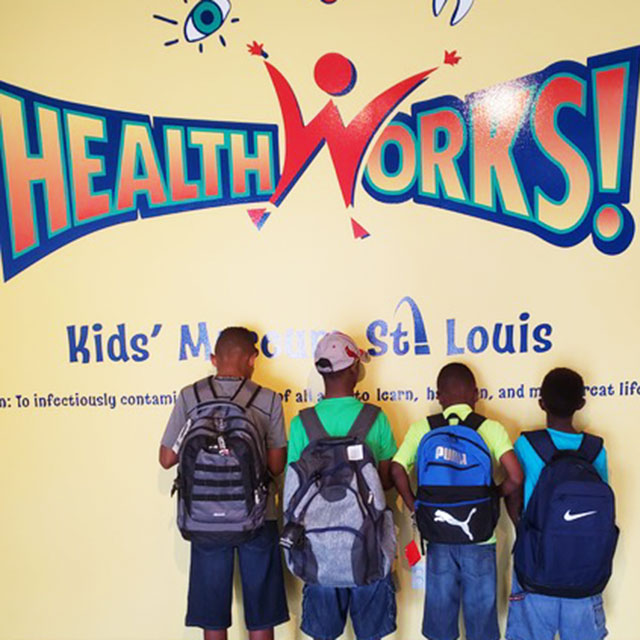When Health Education Works
It’s a look. A laugh. A light in the eyes. “We call it the ‘ah-ha-rah-ooh’ effect when the science has left them either cheering or grossed out…when you know that you’ve reached a child and learning has taken place,” says Shannon Laine, President and CEO of HealthWorks! Kids’ Museum St. Louis, the region’s only children’s museum dedicated solely to health education. HealthWorks! is a 2019 YouthBridge YEP (Youth Engaged in Philanthropy) grant recipient.
The brainchild of a handful of innovative dentists in the 1970s to create a learning theater that would teach kids about oral health, the program had stayed virtually unchanged for 30 years. When Laine, a professional actor with degrees in early childhood education and nonprofit management, arrived in 2008, she envisioned something completely new and relevant to the 21st century.
“At the time, many of our exhibits were hands-off. That’s not how children learn best, we’ve discovered,” says Laine. “We wanted something that was completely interactive, fun and full-blown health education to help children learn healthy life habits.”
With the backing of its long-time sponsor, Delta Dental of Missouri, and other supporters and partners, the theater moved from its nearly 40-year location on Laclede’s Landing in 2016 to a 15,000 sq. ft. space near the Saint Louis Science Center, becoming the HealthWorks! Kids’ Museum. There are hands-on exhibits and educator-led programming covering nutrition, anatomy, what to expect on a trip to the doctor or dentist – even a whole “Grossology” section explaining how sounds and smells and the like are formed in the body. And, of course, there is oral health education, “using the information we have now on its correlation to whole body health,” says Laine.
The T-Rex of this museum is a 55-foot-long, 25-foot-wide, 8-foot-tall human skeletal structure/indoor playground known as the “Interactive Dude.” The Dude was designed to allow for children with physical and developmental disabilities to feel comfortable playing and learning; and the lights, sounds and materials used to build the structure were intended to benefit children with unique sensory needs.
Making the museum accessible to all was a priority, says Laine. “We want children of all abilities – physical or economic – to experience the museum,” she says. Scholarships and transportation are provided for classrooms in underserved communities, and the museum is open to the public five days a week for a nominal $7 admission fee. Foster and adoptive families are free, and a back-to-school event in collaboration with the Foster and Adoptive Care Coalition (made possible this year through the YEP grant) provides uniforms, backpacks and shoes to foster families every August.
The museum continues to grow in popularity, with an estimated 36,000 children and caregivers visiting each year, and in exhibits – a new “Skin Crawl Wall” is scheduled to open in late October – but the real measure of success, says Laine, is an increase in knowledge. “Parents will comment that their child now sits still for the dentist because they know what to expect, and teachers have discovered students separating their lunches by food groups. Some even jokingly complain that their students spend too much time in the bathroom washing their hands. It says to me that what we’re teaching is sticking.”
